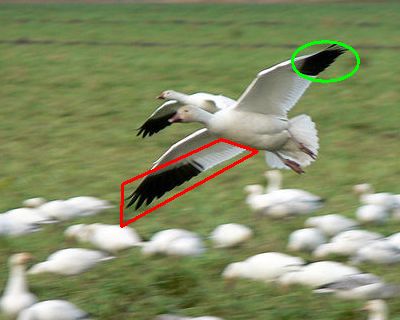 If you’ve been birding for a while you’ve probably heard, even used, the word “primaries” but the word remiges could be new to you. It was to me.
If you’ve been birding for a while you’ve probably heard, even used, the word “primaries” but the word remiges could be new to you. It was to me.
Let’s tackle these two terms in reverse order since remiges are a more general term.
Remiges (pronounced REH.midg.iz) are the flight feathers on a bird’s wing, outlined in red in this picture.
Remiges include all the flight feathers – primaries, secondaries and tertials – and make up the entire trailing edge of the wing.
So what are the primaries?
Answer: David Sibley describes them as “flight feathers growing from the “hand” bones and forming the lower border of the folded wing.”
The snow goose is an easy example, a white bird with black primaries. I’ve circled his primaries in green above.
A quick way to think of primary feathers is that they’re where the bird’s fingers would be. The difference is that there are 9 to 11 of them, sometimes more depending on the species, so they extend around the lower edge of the wing. If you had 10 fingers on each hand, where would you put them? Probably where the bird puts his.
Primaries are easy to see on large birds in flight. Watch soaring red-tailed hawks and you’ll see that they spread their primaries and tip them up to reduce wingtip vortex. Aircraft engineers design upturned wingtips on airplanes for the same reason.
So… the primaries are feathers where the birds fingers would be, and all primaries are remiges (wing flight feathers) but not all remiges are primaries.
Another excellent lesson!
I love these lessons. I look at birds so much different now. Thank you
Faith.
Interesting. I have a question regarding primaries though. When reading your article on the history of breeding pairs at Pitt, Downtown, and elsewhere, I noticed a number of previous fledgelings had been injured in some way and weren’t releasable. One of these said “Primaries damaged, not releasable” So are the primary feathers unable to regenerate if lost or did this bird sustain a wing injury that disrupted the growth of these feathers?
Birds replace their wing feathers as well as their body feathers when they molt. However it’s possible to damage the “hand” area from which the feathers grow such that the feathers won’t grow properly. The flying equipment on peregrines has to be in top condition because they have to fly better than the birds they hunt. Otherwise they starve. An injury that misshapes the primaries makes the bird unreleaseable.